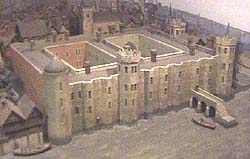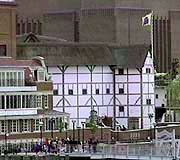|
Tudor London
By David Nash Ford
The first monarch of the Tudor
dynasty had a great impact on London architecture
in the form of 'Henry VII's Chapel,' the addition
he made to the eastern end of Westminster Abbey.
The antiquarian, John Leland, considered it to be
a 'Wonder of the World'. It is certainly a
triumph of renaissance architecture. Henry VII planned it as a shrine-chapel for the
body of his half-uncle, the pious King Henry VI.
But the Pope would not canonize him and the place
became Henry VII's own mausoleum. His main
residence was Baynard's Castle which he rebuilt
in a more palatial style than its predecessor. He was the last 
Baynard's Castle stood first on the river-bank close to the Fleet Tower and the western extremity of the city wall. The great house which afterwards bore this name was on the bank, but a little more to the east. The name survived in Baynard's Castle Ward and Wharf. There was no house in the City more interesting than this. More
|
|
monarch to have
a permanent residence within the city walls. He
also rebuilt the Palace of Sheen, when it burnt
to the ground in 1498, and had it renamed as
Richmond Palace. He died there in 1509.
His son, Henry VIII, was another great palatial builder. He
expanded York House, the London residence of the
Archbishop of York, to become the Palace of
Whitehall, joining Westminster with Charing
Cross. He also erected Bridewell Palace (the name
derives from an ancient holy well), south of
Fleet Street just west of the city, when the
Royal apartments at Whitehall were wrecked by
fire. New lodgings at Bridewell were needed to
house the retinue of the Emperor Charles V when
he visited London in 1522. Charles himself stayed
with the Blackfriars next door. Henry also built
St. James' Palace and the now lost Palace of
Nonsuch. He confiscated Hampton Court from
Cardinal Wolsey and added much of what we see
there today. However, Henry's favourite residence
was Greenwich Palace, where he had been born; and
it thus became the scene of many important
historical episodes during his reign.
Like the Archbishops of York at
Whitehall, the prelates from Canterbury had a
London home across the river at Lambeth Palace.
The complex was originally established in 1197
and a medieval chapel crypt survives where the
hearings for Henry VIII and Anne Boleyn's divorce
were heard. Most of the present building is Tudor
including the Gatehouse and Great Hall. Its
Lollards Tower was where the heretical followers
of John Wycliff were imprisoned.
In social and economic, as well
as architectural terms, the Reformation
was to be the defining event of the Tudor period
in the capital. At the start of Henry VIII's
reign, London was filled with splendid religious
buildings, the treasures of previous centuries.
During the Dissolution of the Monasteries, vast
numbers of these were destroyed or adapted to
secular use and the damage was still widely
visible in Elizabeth I's time. Most of the monastic orders and
friars quickly submitted to the will of the King
and lost their great and long-established
buildings. However, the Carthusian Church of
Charterhouse, in Smithfield, was more reluctant
than most to surrender. Its Prior was dragged
through the streets on a hurdle and hung, drawn
and quartered at Tyburn. His severed arm was
nailed to the Priory Gate as a warning to the
rest of the community, but they held out for
three years before the execution of fifteen of
their number persuaded them to leave. The
buildings were incorporated into a great town
house for one of the King's Royal Courtiers.
Much of the plunder of the
church was used to the advantage of private
citizens in this way, and conversions continued
into the reign of Edward VI. In 1547, the Duke of Somerset used
stone from Clerkenwell Priory and St. Paul's
Charnel House to build himself a magnificent
Renaissance Palace on the Strand. The Strand Inn
and the Church of the Nativity, as well as the
houses of the Bishops of Chester and Worcester,
were torn down to make way for this new Somerset House. The losses of the church presented
great opportunities for the City Livery Companies
too and they claimed many fine buildings for
themselves from those left redundant.
More benevolent foundations
were established by King Henry VIII himself. He
claimed to be the (re-)founder of the medical
hospital of St. Bartholomew, which still survives
today; as do large parts of the adjoining priory
and church of the same name. Similarly, he
claimed to have refounded St. Thomas's Hospital,
also still extant, though it was moved, in the
19th century, from the Southwark side of London
Bridge to Lambeth. The refoundation of the
Bethlehem Hospital for the mentally ill (Bedlam),
outside Bishopgate, was also laid at Henry's
door.
These changes meant that the
poor of the city were no longer able to gain help
from the monasteries. In the final years of
Elizabeth I's reign, the first realistic Poor Law
Act was introduced. Until then, the poor had
largely been oppressed. The fall of the monastic
way of life also left a void in the city's
education system, such as it was. King Edward VI
gave Bridewell Palace to the city as a boys'
training house for industry (and also a
penitentiary). Similarly, Christ's Hospital
School for the education of poor children, was
created from the Greyfriars' buildings at
Newgate. However, it was largely the efforts of
the rising merchants which helped the situation
by their establishing new educational
foundations. Many well-known public schools,
founded through the generosity of city merchants,
date from this time, including: Charterhouse, St.
Paul's, the City of London School, the Merchant
Taylors' and Mercers' Schools. Though the Inns of
Chancery were in decline, the Inns of Court
continued their educational role in the city and
their great halls are a magnificent survival from
the Tudor age. The Old Hall at Lincoln's Inn
dates from 1490, Gray's Inn from 1556 (though
much restored in 1951) and Middle Temple from
1573. Shakespeare performed several of his plays
in them.
Queen Mary, in 1554, when Sir Thomas Wyat marched
on the city but was unable to enter the Ludgate
because it had been closed against him. The
second was led by the Earl of Essex against
Elizabeth I in 1601, but neither held much chance
of success as the Londoners were not willing to
support them.
The accession of Queen Mary was
delayed a little by the proclamation, at
Baynard's Castle, of Lady Jane Grey, who reigned for nine days. The mayor was absent from this ceremony and the people are
said to have been unenthusiastic. In contrast, on
July 11th 1553, the mayor and the Recorder and
crowds of aldermen attended Mary's proclamation

A reconstructed Globe Theatre stands on the Southbank near the site of the original Globe. If you are lucky, you can attend a performance at this open air venue in the summer. Click to visit Shakespeare's Globe for information. You can book tickets over by phone (020 7401 9919) using a credit card.
|
|
as Queen. This lady was a staunch catholic, like
her Spanish mother, and her time on the throne
was not a happy period for Londoners, many of
whom had embraced the Protestantism of Mary's
brother's reign. In only four years she had some
200 Protestant martyrs burnt at Smithfield for
not renouncing their faith.
Elizabeth I's accession to the throne eventually brought more
relaxed times to the people of London. It was the
heyday of the English theatre, and Londoners
flocked to Southwark as the entertainment capital
of the city. Here were the Hope, the Swan, the Rose and the Globe: great theatres all. The
latter two were the work places of William
Shakespeare who spent most of his life in this
area of London. Less official performances were
executed at the many galleried inns in the nearby
streets. There were also more base entertainments
available such as bear baiting or cock-fighting.
Then, of course, there were the brothels.
Southwark was famous for its ladies of the night
who worked from the stews on the Bishop of
Winchester lands. The Bishop regulated the
industry and made himself a tidy profit.
After the attempted invasion of
Britain by the Spanish Armada in 1588, when the
loyal Londoners raised a large band of men to
help defeat the invaders, England became more
politically stable. There was a marked increase
in prosperity and the population of London grew
accordingly. The core of the city was built
around the lands seized from the church and we
begin to see the richer citizens moving out to
country estates to the west of the city along the
Thames where many of the old bishops' palaces
were rebuilt for use by the nobility. The
detailed maps, by Van den Wyngaerde, Braun and
Hogenberg, as well as Ralph Agas, give a much
clearer picture of the layout of the city than we
have from previous times.
Next: Stuart
London
|
© 2016 offtolondon.com All rights reserved.
Contact Us |
|
|
| |